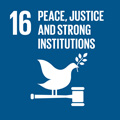- Docente: Patrizia Pederzoli
- Credits: 8
- SSD: SPS/04
- Language: Italian
- Teaching Mode: Traditional lectures
- Campus: Forli
-
Corso:
Second cycle degree programme (LM) in
Criminology for Investigation and Security (cod. 8491)
Also valid for Second cycle degree programme (LM) in International relations and diplomatic affairs (cod. 6058)
Second cycle degree programme (LM) in International Relations and Diplomatic Affairs (cod. 9247)
-
from Feb 19, 2025 to May 29, 2025
Learning outcomes
By the end of the course the students know concepts, models and analytical tools allowing them to understand the role that judicial institutions play in contemporary democracies, the increasing influence of courts on collective choices, and the impact of judicial rulings on political systems. By comparing the two main legal traditions - common law and civil law - students are able to detect similarities and differences between national cases, their respective variations over time, and their connections with supranational developments.
Course contents
I Introduction: The political systems and the judicial system - The role of the judge: independence and democratic accountability - The increasing significance of the justice system: the "judicialisation of politics".
II The judiciary and the political system: The institutional settings: the relevant variables - Cases analysis -The governance of the judiciary.
III The relations between justice and politics: The scope of jurisdiction - The role of supreme courts - Access to justice and public prosecution - The powers of the bench: inquisitorial v. accusatorial sytems - The judicial review of legislation: role and functions of constitutional courts - The enforcement of judicial decisions: political factors and public opinion.
IV The supranational dimension: The Court of justice of the European Union - The Cjue and the national courts.Readings/Bibliography
Guarnieri C. e Pederzoli P. (2017), Il sistema giudiziario. L'espansione del potere giudiziario nelle democrazie contemporanee, Bologna, Il Mulino.
(*) Donati F. (2021), Dal Csm ai Consigli di giustizia europei. L'incerta diffusione di un modello costituzionale, in "Quaderni costituzionali", XLI, n. 2, pp. 355-373.
(*) Panebianco A. (2004), Il potere, lo Stato, la libertà, Bologna, il Mulino, capitolo IV.
(*) Magalhaes P.C., Guarnieri C., Kaminis Y. (2006), Democratic Consolidation, Judicial Reform, and the Judicialization of Politics in Southern Europe, in R. Gunther, P.N. Diamandouros, D.A. Sotiropoulus (eds), Democracy and the State in the New Southern Europe, Oxford, Oxford U.P., 2006, only pp. 138-175.
(*) Caravale G. (2020), La Corte suprema in un decennio di cambiamenti istituzionali, in "Materiali per una storia della cultura giuridica", n. 1, pp. 27-45.
(*) Hirschl R. (2008), The Judicialization of Politics, in G.A. Caldeira, R.D. Kelemen, K.E. Whittington (eds), The Oxford Handbook of Law and Politics, Oxford, Oxford University Press, pp. 120-141.
(*) Choudry S. (2024), Constitutional courts, in Smits J.M. et al (eds), Elgar Enciclopedia of Comparative Law, pp. 401-409.Please note that (*) texts will be available on the website Virtuale
Teaching methods
Lectures. When pertinent, institutional websites will be visited.
Assessment methods
Oral exam on the above bibliography aimed to assess the knowledge of the whole syllabus, the ability to connect the various parts of the programme, and overall the proper use of theories and concepts enabling students to carry out comparative analysis.
Teaching tools
Slides.
Office hours
See the website of Patrizia Pederzoli
SDGs



This teaching activity contributes to the achievement of the Sustainable Development Goals of the UN 2030 Agenda.
